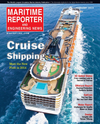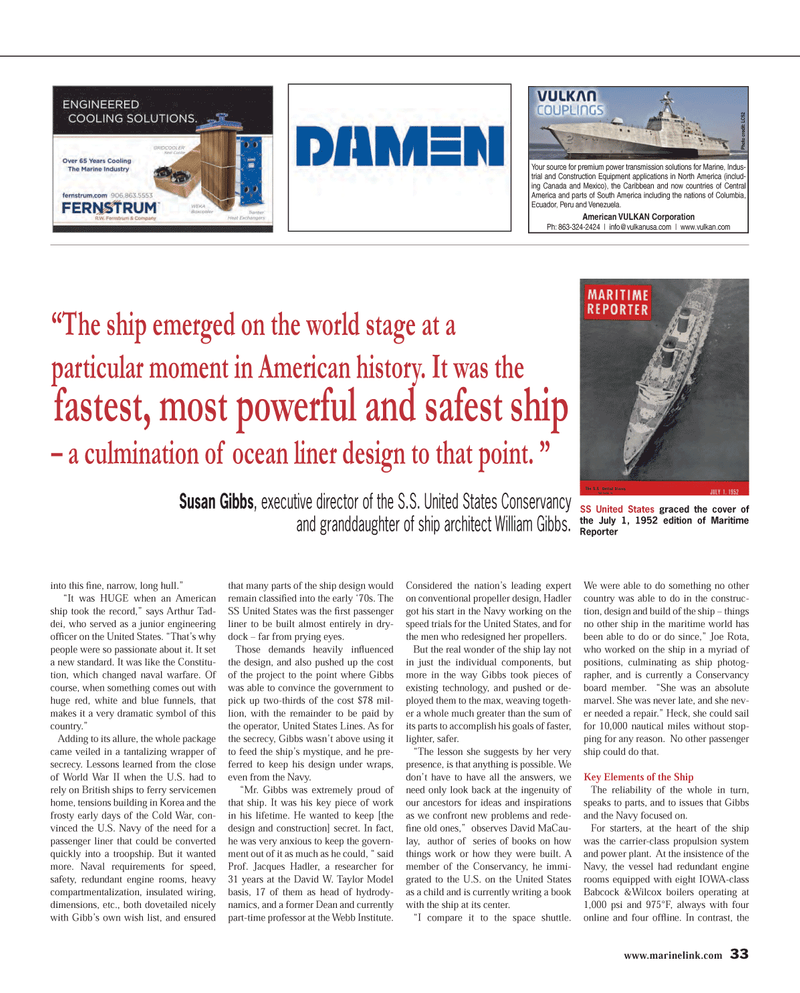
Page 33: of Maritime Reporter Magazine (February 2014)
Cruise Shipping Edition
Read this page in Pdf, Flash or Html5 edition of February 2014 Maritime Reporter Magazine
www.marinelink.com 33 into this fi ne, narrow, long hull.” “It was HUGE when an American ship took the record,” says Arthur Tad- dei, who served as a junior engineering offi cer on the United States. “That’s why people were so passionate about it. It set a new standard. It was like the Constitu- tion, which changed naval warfare. Of course, when something comes out with huge red, white and blue funnels, that makes it a very dramatic symbol of this country.”
Adding to its allure, the whole package came veiled in a tantalizing wrapper of secrecy. Lessons learned from the close of World War II when the U.S. had to rely on British ships to ferry servicemen home, tensions building in Korea and the frosty early days of the Cold War, con- vinced the U.S. Navy of the need for a passenger liner that could be converted quickly into a troopship. But it wanted more. Naval requirements for speed, safety, redundant engine rooms, heavy compartmentalization, insulated wiring, dimensions, etc., both dovetailed nicely with Gibb’s own wish list, and ensured that many parts of the ship design would remain classifi ed into the early ‘70s. The
SS United States was the fi rst passenger liner to be built almost entirely in dry- dock – far from prying eyes.
Those demands heavily infl uenced the design, and also pushed up the cost of the project to the point where Gibbs was able to convince the government to pick up two-thirds of the cost $78 mil- lion, with the remainder to be paid by the operator, United States Lines. As for the secrecy, Gibbs wasn’t above using it to feed the ship’s mystique, and he pre- ferred to keep his design under wraps, even from the Navy. “Mr. Gibbs was extremely proud of that ship. It was his key piece of work in his lifetime. He wanted to keep [the design and construction] secret. In fact, he was very anxious to keep the govern- ment out of it as much as he could, “ said
Prof. Jacques Hadler, a researcher for 31 years at the David W. Taylor Model basis, 17 of them as head of hydrody- namics, and a former Dean and currently part-time professor at the Webb Institute.
Considered the nation’s leading expert on conventional propeller design, Hadler got his start in the Navy working on the speed trials for the United States, and for the men who redesigned her propellers.
But the real wonder of the ship lay not in just the individual components, but more in the way Gibbs took pieces of existing technology, and pushed or de- ployed them to the max, weaving togeth- er a whole much greater than the sum of its parts to accomplish his goals of faster, lighter, safer. “The lesson she suggests by her very presence, is that anything is possible. We don’t have to have all the answers, we need only look back at the ingenuity of our ancestors for ideas and inspirations as we confront new problems and rede- fi ne old ones,” observes David MaCau- lay, author of series of books on how things work or how they were built. A member of the Conservancy, he immi- grated to the U.S. on the United States as a child and is currently writing a book with the ship at its center. “I compare it to the space shuttle.
We were able to do something no other country was able to do in the construc- tion, design and build of the ship – things no other ship in the maritime world has been able to do or do since,” Joe Rota, who worked on the ship in a myriad of positions, culminating as ship photog- rapher, and is currently a Conservancy board member. “She was an absolute marvel. She was never late, and she nev- er needed a repair.” Heck, she could sail for 10,000 nautical miles without stop- ping for any reason. No other passenger ship could do that.
Key Elements of the Ship
The reliability of the whole in turn, speaks to parts, and to issues that Gibbs and the Navy focused on.
For starters, at the heart of the ship was the carrier-class propulsion system and power plant. At the insistence of the
Navy, the vessel had redundant engine rooms equipped with eight IOWA-class
Babcock &Wilcox boilers operating at 1,000 psi and 975°F, always with four online and four offl ine. In contrast, the
American VULKAN Corporation
Ph: 863-324-2424 | [email protected] | www.vulkan.com
Your source for premium power transmission solutions for Marine, Indus- trial and Construction Equipment applications in North America (includ- ing Canada and Mexico), the Caribbean and now countries of Central
America and parts of South America including the nations of Columbia,
Ecuador, Peru and Venezuela.
Photo credit: LCS2
American Vulkan MR Jan14.indd 1 12/19/2013 9:55:54 AM “The ship emerged on the world stage at a particular moment in American history. It was the fastest, most powerful and safest ship – a culmination of ocean liner design to that point. ”
Susan Gibbs, executive director of the S.S. United States Conservancy and granddaughter of ship architect William Gibbs.
SS United States graced the cover of the July 1, 1952 edition of Maritime
Reporter
MR #2 (32-41).indd 33 2/3/2014 10:23:51 AM

 32
32

 34
34
